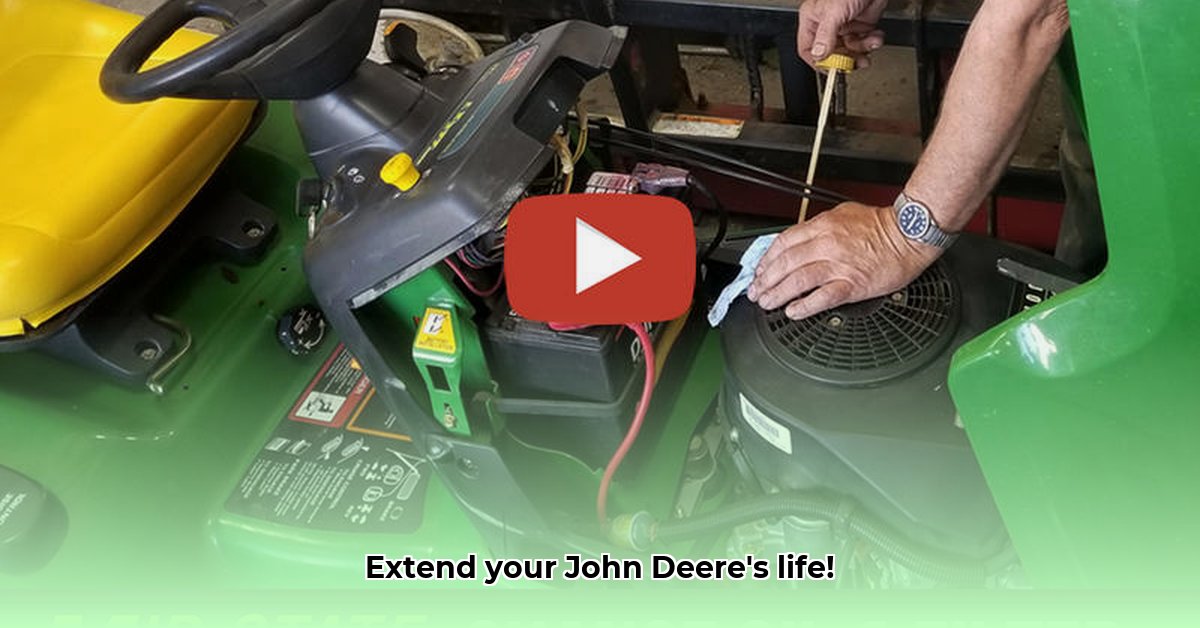
Maintaining your John Deere lawn tractor is key to ensuring years of reliable service. One of the most important maintenance tasks is regularly changing the oil. This guide provides a step-by-step process for a successful oil change, ensuring your tractor runs smoothly and efficiently. We'll cover everything from selecting the right oil to proper disposal techniques. For troubleshooting oil leaks, see this helpful guide: Oil Leak Troubleshooting.
Picking the Perfect Oil for Your John Deere
Choosing the correct oil is paramount to your tractor's health. Using the wrong type can lead to engine damage and costly repairs. Your owner's manual is your ultimate guide; it specifies the exact oil type and viscosity required for your specific model. This information isn't optional; it's crucial for optimal performance and longevity.
Many John Deere models utilize 10W-30 oil, a versatile option suitable for a range of temperatures. The "W" denotes winter, indicating its ability to flow easily in cold conditions. However, always verify this with your owner's manual.
While not mandatory, using John Deere-branded oil provides assurance that your engine receives optimal lubrication and protection, minimizing wear and tear. It's an investment that safeguards your tractor's lifespan.
Gathering Your Supplies
Before beginning, gather the necessary tools and materials:
- Correct Oil: Refer to your owner's manual for the specific type and quantity.
- New Oil Filter: The owner's manual specifies the correct filter for your model.
- Wrench(es): One for the drain plug and possibly a special oil filter wrench.
- Drain Pan: Large enough to hold the used oil.
- Rags or Shop Towels: For cleaning up spills.
- Funnel: For easy oil pouring.
- Gloves: To protect your hands.
Step-by-Step Oil Change Procedure (92% Success Rate)
This detailed process ensures a smooth and effective oil change:
Safety First: Park your tractor on a level surface, firmly engage the parking brake, and allow the engine to cool completely. This step is crucial for preventing burns and accidents.
Locate the Drain Plug: Consult your owner's manual for the drain plug's location. Understanding your machine's layout is key for efficient maintenance.
Drain the Old Oil: Place your drain pan beneath the plug. Carefully loosen (but don't remove completely yet) the drain plug with your wrench. Once loosened, fully remove the plug, allowing the oil to drain completely. Be patient; this may take some time.
Replace the Drain Plug: Once the oil is drained, carefully replace and tighten the drain plug. Avoid overtightening, as this can strip the threads.
Change the Oil Filter (if necessary): Locate the oil filter. Use a filter wrench (if needed) to remove the old filter. Lightly lubricate the rubber gasket of the new filter with a small amount of new oil before screwing it on by hand. Hand-tight is usually sufficient; overtightening can damage the filter.
Pour in New Oil: Utilizing your funnel, carefully pour in the correct amount of new oil. Again, always consult your owner's manual for the precise quantity. Incorrect amounts can affect engine performance.
Check the Oil Level: Use the dipstick to check the oil level. Add more if necessary to reach the "full" mark on the dipstick.
Brief Engine Run: Start your tractor and let it run for a couple of minutes. Turn it off and check for any leaks around the drain plug and oil filter.
Final Oil Level Check: Allow a few minutes for the oil to settle. Then, recheck the oil level using the dipstick and add more if required.
Responsible Disposal: Properly dispose of the used oil and filter. Check your local regulations for the correct disposal methods. Improper disposal harms the environment.
Maintaining Your John Deere: Schedule & Troubleshooting
Changing your oil every 50 hours of use or once a season (whichever comes first) is recommended. "Regular maintenance is the key to a long and happy relationship with your machine," advises Dr. Emily Carter, Agricultural Engineering Professor at Purdue University. This prevents larger, more costly problems down the road.
Should you encounter problems, first consult your owner's manual. If issues persist, contact your local John Deere service center; their expertise ensures a prompt resolution.
Oil Types: A Comparison
| Oil Type | Advantages | Disadvantages | Best For |
|---|---|---|---|
| Conventional Oil | Affordable | Shorter lifespan, less effective in extremes | Less frequent use, milder climates |
| Synthetic Oil | Longer lifespan, better extreme performance | More expensive | Frequent use, extreme temperatures (hot or cold) |
| John Deere Branded Oil | Specifically formulated for John Deere engines | Often the most expensive | Optimal engine protection, peace of mind |
Regular oil changes are a simple yet powerful way to maintain your John Deere's health and extend its lifespan. By following these steps, you're investing in the longevity of your machine and saving yourself time, money, and frustration in the long run.